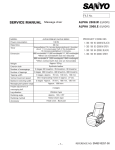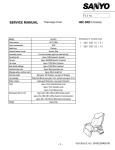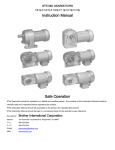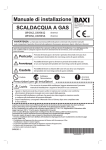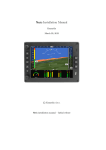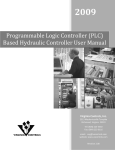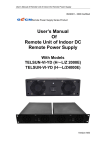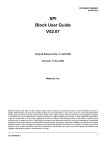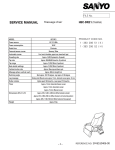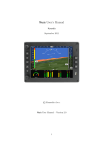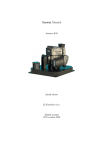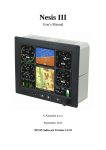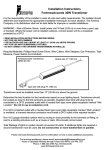Download SERVICE MANUAL Massage chair
Transcript
FILE No. SERVICE MANUAL Massage chair HEC-902 (GENERAL) HEC-904 (GENERAL) MODEL Power consumption Rated time Timer Dimension Weight Exterior cloth Number of massagings Number of tappings Tapping width HEC-902 HEC-904 90 W 130 W 30 min [manual]about 15 minutes,[automatic]neck / shoulder about 11 minutes,[upper half of the body]about 13 minutes,[waist]about 13 minutes. 660 mm(width) X 1,000 mm(depth) X 1,030 mm(height) *When not reclined(with foot rest retracted) 660 mm(width) X 1,650 mm(depth) X 570 mm(height) *When reclined (with foot rest set horizontally) Approx. 50 kg Approx. 52 kg Polyester chloride 100 % 3 stages 20 times/min., 25 times/min., 30 times/min. 3 stages 360 times/min., 480 times/min., 600 times/min. 3 stages Approx. 70 mm, 100 mm, 130 mm Vertical movement speed One reciprocating motion in approx. 27 sec. Backborn stretching width 3 stages Approx. 70 mm, 100 mm, 130 mm Massaging ball up/down range Approx. 600 mm Height adjustment of 3 stages massaging ball. Leg vibration Reclining angIe Reclining method Accessory Vibration type Approx. 120~170 Manual method Motor-driven type Head cover - 1- REFERENCE NO. SM6510035-00 CN10 Switch Transfomer CN201 CN13 Printed board (Main) Printed board (Relay) CN203 Limit switch CN14 CN4 Condenser (10 F 250V) CN3 Motor (Elevation) CN2 - 2- Motor (Leg vibrator) CN6 CN8 CN11 CN101 Printed board (Remote control) CN9 CN1 Fuse (250V 3.15A) (Massage) Transfomer Wiring Diagram Motor Limit switch CN301 CN202 Reactor HEC-902 (GENERAL) CN7 Printed board (Massage pulse) Reactor Reactor Limit switch Motor (Tapping) Reactor Circuit Diagram Printed board (Relay) Motor (Massaging) IC 202 Massaging pulse Printed board (Pulse) Tapping pulse IC 301 Condenser ( 10 F 250 V ) Reclining motor - 3Motor (Leg vibrator) Fuse Switch ( 250 V 3.15 A ) Printed board (Remote control) Transfomer HEC-902 (GENERAL) Printed board (Main) RESET SO SI SCLK 5V GND Printed board (Main) Circuit Diagram Printed board (Remote control) - 4HEC-902 (GENERAL) CN10 Switch Transfomer Printed board (Main) Printed board (Relay) Limit switch CN301 Reclining motor CN7 Reactor HEC-904 (GENERAL) Switch Printed board (Massage pulse) CN12 Switch CN5 Motor CN202 Reactor CN203 Limit switch CN14 CN4 Condenser (10 F 250V) CN201 CN3 Motor (Elevation) CN13 CN2 - 5- Motor (Leg vibrator) CN6 CN8 CN11 CN101 Printed board (Remote control) CN9 CN1 Fuse (250V 3.15A) (Massage) Wiring Diagram Motor Transfomer Reactor Limit switch Limit switch Motor (Tapping) Reactor Circuit Diagram Printed board (Relay) Motor (Massaging) IC 202 Massaging pulse Reclining motor Printed board (Pulse) Tapping pulse IC 301 Condenser ( 10 F 250 V ) -6- Reclining motor Motor (Leg vibrator) Fuse Switch ( 250 V 3.15 A ) Printed board (Remote control) Transfomer HEC-904 (GENERAL) Printed board (Main) RESET SO SI SCLK 5V GND Printed board (Main) Circuit Diagram Printed board (Remote control) - 7HEC-904 (GENERAL) Troubled portion Trouble phenomenon Power and Nothing is displayed after the remote control power ON. relations Nothing is displayed -8- Remote control Trouble described left is relations displayed immediately or 3 seconds after the power switch is turned ON. 3. Check Printed board (Main) CN9 output (AC100V). 4. Check power transformer output CN10 (approx. 12V). 5. Check Printed board (main) CN11 and Printed board (remote control) CN101 for connector come-off. Check pins (both No.5 (brown) and No.7 (black), or No.1 (white) and No.2 (red) for come-off.) 6. Check the remote control cable for disconnection or shorting. (both brown and black wires or white and red wires) 7. When no fault is detected upon checking in Step 1 - 6; Immediately or 3 1. Check the Printed board (main) CN11 and Printed board (remote control) seconds later CN101 connector pins for come-off. (Pin No. 3 (blue), 4 (yellow), and 6 (orange) 2. Check the remote control cable for disconnection or shorting. (Blue, yellow and orange wires) 3. When no fault is detected upon above check; Counteraction method Replace the current fuse (3.15A). Check the power switch and power cord and transfomer for normal conductivity and replace them if necessary upon check. Replace the Printed board (main). Replace the power transformer. Insert the connector and pins. Replace the remote control cable. Replace the Printed board (remote control) or Printed board (main). Insert the connector pins. Replace the remote control cable. Replace the Printed board (remote control) or Printed board (main). HEC-902 (GENERAL) HEC-904 (GENERAL) The power lamp,and massage red lamp, tapping red lamps, stretch 1 red lamps, stretch 2 red lamps, combi red lamps lighting. Occurrence condition Check item (after power "ON") Immediate 1. Check current fuse (3.15A) for fusion. 2. Check Printed board (Main) CN1 output (AC100V). Problem diagnosis chart Trouble indication pattern Troubled portion Trouble phenomenon Counteraction method Insert the connector. Replace the main harness If output Replace the massage motor. If no output Replace the Printed board (main). Insert each lead wire pin. Problem diagnosis chart Occurrence condition Check item (after power "ON") Massage Trouble Massaging 15 seconds later 1. Check the Printed board (main) CN6 motor relations described left is failure or 15 seconds and CN7 and massage motor displayed 15 after massaging junction connector for come-off. seconds after motion 2. Check the harness between the the power is Printed board (main) CN6 and massage turned ON or motor junction connector for "MASSAGE" is disconnection. selected. during massage 3. Check the Printed board (main) CN6 output (approx. DC57 - 100V). Massaging 15 seconds later 4. Check the Printed board (relay) CN201 connector and Printed board mode remains or 15 seconds (main) CN13 connector for unchanged. after massaging come-off of each lead wire pin motion (Pin No. 3 (brown), 4 (yellow) and 7 (white).) The power lamp, the 5. Check the main harness CN201 to center of the width CN13 line for disconnection or lamp and massage red shorting. lamp, tapping red lamps, stretch 1 red 6. Check the massaging "POSITION" lamps, stretch 2 red and "ROTATION" magnets for their lamps, combi red mounting direction and fall-down. lamps lighting. 7. Check the Printed board (relay) IC 201 and IC 202 for inclination. Massage motor 8. Check the belt (MOMI) for running dislocation and cut-off. 9. When no fault is detected upon checking in the Step 1 - 8; Trouble indication pattern Replace the main harness Mount the magnet in normal condition. - 9- Correct the tilted condition or replace the Printed board (relay). Mount or replace the belt (MOMI). Replace the Printed board (relay) or the Printed board (main). HEC-902 (GENERAL) HEC-904 (GENERAL) Troubled portion Trouble phenomenon Tapping motor Trouble Tapping failure described left is relations displayed 15 seconds after the power is turned ON or "TAPPING" is selected. Tapping mode remains unchanged. - 10- The power lamp, the center of the width lamp and massage red lamp, tapping red lamps, stretch 1 red lamps, stretch 2 red lamps, combi red lamps lighting. Tapping motor running Occurrence condition Check item (after power "ON") 15 seconds later 1. Check the Printed board (main) CN8 and CN14 and the tapping motor or 15 seconds junction connector for come-off. after tapping 2. Check the Printed board (main) CN8 motion to tapping motor connector harness for disconnection. during tapping 3. Check the Printed board (main) CN8 output (approx. DC57 100V). 15 seconds after 4. Check the Printed board (relay) CN202 connector for come-off and tapping motion pins for come-off. 5. Check the Printed board (pulse) CN301 connector for come-off and pins for come-off. 6. Check the Printed board (relay) CN201 and Printed board (main) CN13 connectors for come-off of each lead wire pin (No.2). 7. Check the junction harness (CN202 - CN301 circuit) for disconnection or shorting. 8. Check the tapping magnet for its mounting direction and fall-down. 9. Check the Printed board (pulse) IC 301 for inclination. 10. Check the belt (TATAKI) for dislocation and cut-off. 11. When no fault is detected upon check in Step 1 - Step 10; Counteraction method Insert the connector. Replace the main harness If output Replace The tapping motor. If no output Replace the Printed board (main). Insert the connector and pins. Insert the connector and pins. Problem diagnosis chart Trouble indication pattern Insert each lead wire pin. Replace the junction harness Mount the magnet in normal condition. Correct the tilted condition or replace the Printed board (pulse). Mount or replace the belt (TATAKI). Replace the Printed board (relay or pulse) or the Printed board (main). HEC-902 (GENERAL) HEC-904 (GENERAL) Troubled portion Trouble phenomenon Counteraction method Insert the connector and pins. If output from the both Replace the elevation motor. If either or neither from the both Replace the Printed board (main). Problem diagnosis chart Occurrence condition Check item (after power "ON") Elevation Elevation failure During elevation 1. Check the Printed board (main) CN3 motor relations or 30 seconds and CN4 connectors for come-off later and pins for come-off. 2. Pull out CN3 on the Printed board (main) and check for the red pin to white pin output and blue pin to white pin output of the Printed board side CN3 (to be approx. AC100V respectively). *For checking, turn ON the massager from the remote control and keep either vertical adjust button "UP" or "DOWN" as pressed. 3 seconds later 3. Check the Printed board (relay) Trouble described left is CN201 connector for come-off. displayed 3 seconds after the The power lamp, the 4. Check the Printed board (relay) power is turned ON. center of the speed CN203 connector for come-off. (The upward motion is effected lamp, and massage red immediately only after the power 5. Check the Printed board (main) CN13 lamp, tapping red connector for come-off. is turned ON.) lamps, stretch 1 red lamps, stretch 2 red 6. Check the Printed board (relay) lamps, combi red CN201 connector and Printed board lamps lighting. (main) CN13 connector for come-off of each lead wire pin thereof (both No.1 (black) and No.6 (red), or No.5 (blue). 7. Check the main harness (CN201 to CN13) for disconnection or shorting. (No.1 (black), No.6 (red) and No.5 (blue) ) Trouble indication pattern Insert the connector. Insert the connector. Insert the connector. Insert each lead wire pin. - 11 - Replace the main harness. HEC-902 (GENERAL) HEC-904 (GENERAL) Troubled portion Trouble phenomenon Elevation Trouble described left is motor relations displayed 3 seconds after the power is turned ON or after starting elevation. (Start elevation.) Occurrence condition Check item (after power "ON") 3 seconds later or 8. Check the upper and lower limit 30 seconds after switches for trouble elevation (micro switch and harness). < Under normal condition > 1. Stop at the highest position Counteraction method Replace the connector ass'y (upper and lower limit switches). (upper limit switch ON, lower limit switch OFF) Pin 1 - 2 (white - red) of CN203 connector (open) Pin 3 - 4 (green - yellow) of CN203 0 (close) 2. Stop at the middle position. Problem diagnosis chart Trouble indication pattern (Upper limit switch OFF, lower limit switch OFF) Pin 1 - 2 (white - red) of CN203 connector - 12- The power lamp, the center of the speed lamp, and massage red lamp, tapping red lamps, stretch 1 red lamps, stretch 2 red lamps, combi red lamps lighting. 0 (close) Pin 3 - 4 (green - yellow) of CN203 0 (close) 3. Stop at the lowest position. (Upper limit switch OFF, lower limit switch ON) Pin 1 - 2 (white - red) of CN203 connector 0 (close) Pin 3 - 4 (green - yellow) of CN203 connector (open) 30 seconds after 9. Check the elevation magnet for the Mount the magnet in normal condition. When "STRETCH 2" mode is mounting direction and fall-down. selected, "STRETCH 1" motion is elevation 10. Check the Printed board (main) IC4 Correct the tilted condition or replace the effected and trouble described left is displayed. for tilt. Printed board (main). Trouble described left is displayed 11. Check the belt (ROLLING) for Mount or replace the belt (ROLLING). with no elevating motion. (The dislocation and cut-off. elevation motor running) 12. When no fault is detected upon Replace the Printed board (relay or pulse) check in Step 1 ~ 11; or the Printed board (main). HEC-902 (GENERAL) HEC-904 (GENERAL) Troubled portion Trouble phenomenon Problem diagnosis chart Occurrence condition Check item Counteraction method (after power "ON") 1. Check the Printed board (main) CN5 Insert the connector and pins. Trouble described left is displayed When the Motorized with no reclining motion. motorized reclining connector and pins for come-off. If output, Replace the reclining motor. reclining operation is relations 2. Check the Printed board (main) CN5 If no output Replace the Printed board (main). effected normally; (HEC-904 only) output (to be approx. DC90V). Trouble described left is displayed 3 seconds later 3. Check the Printed board (main) CN12 Insert the connector. connector for come-off. three minutes after the power ON. 4. Pull out the Printed board (main) CN12 When the both are (open); connector and check whether the current is across No.1 to No.2 pin and Replace the reclining motor. No.3 to No.4 pin of the motorized recliner side CN12 connector. 3 seconds later 5. Pull out the Printed board (main) CN5 occur Replace the Printed board (main). connector for shorting No.1 to No.2 No occur Replace the reclining motor. The power lamp, the circuit of CN12. Turn ON the power center of the speed lamp, switch after shorting Pin No. 3 to the center of the width 4, to check whether trouble is lamp and massage red displayed or not. lamp, tapping red lamps, stretch 1 red lamps, 6. When no fault is detected upon Replace the Printed board (main). stretch 2 red lamps, check in Step 1 - 5; Trouble indication pattern - 13 - combi red lamps lighting. Other No Replace the Printed board (main). HEC-902 (GENERAL) HEC-904 (GENERAL) The power lamp, the both edges of the speed lamp, and massage red lamp, tapping red lamps, stretch 1 red lamps, stretch 2 red lamps, combi red lamps lighting. Trouble described left is displayed. No trouble is displayed. Leg vibrator Trouble phenomenon Leg vibrator fails to start. Occurrence condition Check item Counteraction method (after power "ON") Leg vibrator "ON" 1. Check that Leg vibrator. If the lamp OFF lamp on the remote control is ON. Check and replace the Printed board (remote control). Various Remote control Trouble is displayed (motion stop) Each function in relations from time to time. running 2. Check the Printed board (main) CN2 If output Replace the cushion (footrest). If no output Replace the Printed board (main). output (to be approx. DC12V). 1. Start massaging in "AUTO" mod and Replace the remote control. lightly pull the remote control cord to check whether massaging motion stops or trouble is displayed. Problem diagnosis chart Troubled portion Trouble indication pattern ( ON-Printed-board Connectors Configuration Drawing ) CN9 CN5 CN6 CN8 CN3 3 2 1 1 2 3 IC202 CN202 IC301 1 2 3 CN30 CN7 - 14- CN1 CN14 CN4 IC201 CN2 CN201 CN10 Printed board (pulse) CN203 IC4 4 3 2 1 1 2 3 4 5 6 7 4 3 2 1 Printed board (relay) CN12 CN13 7 6 5 4 3 2 1 CN11 7 6 5 4 3 2 1 CN5 and CN12 available for HEC-904 only. Printed board (main) HEC-902 (GENERAL) HEC-904 (GENERAL) Motorized Reclining HEC-904 (GENERAL) The back rest can recline steplessly up to 170 degree maximum by operating "RECLINING" switch on the remote control. Back rest Motorized reclining operation 1. The reclining motor rotates both clockwise and counterclockwise to make the cylinder stroke length adjustable. 2. The cylinder stroke length is made shorter simultaneously with startup of the reclining motor, so that the backrest is pulled and reclines from the frame supporting center by the cylinder. - 15 - Massage motors HEC-902 (GENERAL) HEC-904 (GENERAL) 2 2 1 2, Massage motor 3 1, Tapping motor Screw bar 3, Elevation motor 1, Tapping motor This motor rotates to move the massage balls upward and downward alternately via the driving belt coupled to the motor. (The motor revolutions is adjustable in three steps so that the patting frequency can be changed over to approximately 360, 480 and 600 cycles/minute.) 2, Massage motor This motor rotates to move the massage balls crosswise via the driving belt and gear box coupled to the motor. (The motor revolutions is adjustable in three steps so that the massaging frequency can be changed over to approximately 20, 25 and 30 cycles/minute.) (When patting and stretching the backbone line, the massage ball position (ball moving range) can be changed over in three steps after starting the patting motor.) 3, Elevation motor This motor rotates to transmit its rotating torque to the threaded rod via the driving belt, whereby the massage unit is moved upward and downward. (This motor rotates clockwise and counterclockwise to thereby move the massage unit upward and downward.) Tapping-massaging You can enjoy the good comfort that you can not do by hand tapping-massage, by starting both the tapping motor and the massage motor simultaneously. I-shaped tapping - Z-shaped massaging Massaging same portion can be prevented by moving minutely the massage balls upward and downward by starting the elevation motor while running the tapping motor for tapping operation or the massage motor for massaging operation. - 16- Replacement procedure HEC-902 (GENERAL) HEC-904 (GENERAL) (1) How to remove the rear cover (3) Replacement of power switch 1. Unscrew four fixing screws to remove the rear cover. Fig.1 1. Unscrew two case fixing screws to remove the power switch. Photo.4 * In removing, shift the switch in arrow direction from the bushing of the remote control cord. Remote control Rear cover Bushing of the remote control cord Power switch Screws Screws Fig.1 (2) Replacement of the printed board (main) Photo.4 1. Unscrew three fixing screws to remove the cover (the printed board, main). Photo.2 2. Open the power fuse case to take out the fuse. Photo.5 3. Unscrew two switch holder fixing screws to Screws remove the power switch. Photo.5 4. Pull out the auxiliary connector outward, which is fitted in the case (power switch). Photo.5 Screws Fuse Cover(Printed board, main) Photo.2 Power switch 2. Pull out 14 connectors (12 in the case of HEC-902) which are connected to the printed board (main) and thereafter demount the printed board. Photo.3 3. Unscrew two transformer fixing screws to remove the transformer. Photo.3 4. Unscrew two reactor fixing screws and one capacitor fixing screw. Photo.3 Transfomer Screw Printed board(main) Screw Reactor Condenser Photo.3 Connector Cord bushing Photo.5 (4) Replacement of power cord 1. Disconnect the power cord connector to remove the cord bushing from the power cord. Photo.5 (5) Replacement of remote control 1. Remove the bushing from the remote cord. Photo.4 2. Unscrew four remote control case fixing screws to open the case. Fig.1 3. Unscrew two printed board (remote control) fixing screws to disconnect the remote control cord connector. - 17 - Replacement procedure HEC-902 (GENERAL) HEC-904 (GENERAL) (6) Replacement of elevation motor 1. Disconnect the elevation motor lead wires. 2. Remove the belt (Rolling) and unscrew four motor mounting screws. Photo.6 3. Remove the pulley (SM) from the elevation motor output shaft and unscrew four elevation motor fixing screws. Photo.6 Elevation motor (7) Replacement of tapping motor 1. Disconnect the tapping motor cord connector. 2. Remove the belt (TATAKI). Photo.8 3. Unscrew one motor fixing screw. Photo.8 4. Unscrew two stay A (motor T) fixing screws and remove the tapping motor unit. Photo.8 5. Draw the pulley (TM) out of the tapping motor shaft and unscrew three tapping motor fixing screws. Photo.8 Belt (Rolling) Tapping motor Screws Stay A (Motor T) Cord (Red) Pulley(SM) Screws Pulley(TM) Screws Photo.6 Belt (TATAKI) Cautions in reassembling Apply the elevation belt to the pulley and adjust the belt tension as shown in Photo.7. Thereafter, tighten four motor mounting screws with specific torque. Photo.7 Adjust and mount he pulley (SM) so its groove is kept in line with that of the pulley (S). Photo.7 Belt (Rolling) 1kg Screws Cord (Blue) Photo.8 Cautions in reassembling Fix the stay A firmly with two fixing screws so the round portion shown in Photo. 9 is aligned with the holes of the frame and of stay A (motor T). Photo.9. Adjust and mount the pulley (TM) so its groove is kept in line with the groove of pulley (T). Photo.9 Frame Pulley(SM) Stay A (Motor T) Screws In perfect alignment of the holes 6mm Pulley (TM) Pulley (T) Pulley S Screws Photo.7 Be careful not to allow adhesion of grease to the belt drive unit, etc. (Adhesion of grease thereto would result in malfunction due to slip.) - 18- Photo.9 Be careful not to allow adhesion of grease to the belt drive unit, etc. (Adhesion of grease thereto would result in malfunction due to slip.) Replacement procedure HEC-902 (GENERAL) HEC-904 (GENERAL) (8) Replacement of massage motor (9) Replacement of gear box 1. 2. 3. 4. 1. Take off the belt (MOMI). Photo.12 2. Unscrew two stay (HARNESS) fixing screws to remove the stay (HARNESS). Photo.12 3. Unscrew one holder (MAGNET WIDTH) fixing screw to remove the holder (MAGNET WIDTH) from the shaft. Photo.12 4. Take off C-ring from the shaft. Photo.12 Disconnect the massage motor cord connector. Take off the belt (MOMI). Photo.10 Unscrew one motor fixing screw. Photo.10 Unscrew two stay A (motor M) fixing screws to remove the massage motor unit. Photo.10 5. Draw the pulley (MM) out of the massage motor shaft and unscrew three massage motor fixing screws. Photo.10 Belt (MOMI) Screws Holder (MAGNET WIDTH) Stay A (Motor M) Belt (MOMI) Screws Screws Ring C 13 Screws massage motor Cord (Blue) Stay (HARNESS) Screws Screws Photo.12 Photo.10 5. Loosen a little four right-side shaft M fixing Cautions in reassembling Photo.10 screws. Fix the stay A firmly with two fixing screws so 6. Unscrew four gear box fixing screws to the round portion shown in Photo. 11 is aligned separate the gear box from the shaft. with the holes of the frame and stay A (motor M). Photo.13 Photo.11 Adjust and mount he pulley (MM) so its groove is 7. Remove the pulley (M) from the gear box. Photo.13 kept in line with the groove of the pulley (M). 8. Unscrew two stay fixing screws at each side Photo.11 of the gear box to remove the stays Pulley (MM) Frame (left and right). Photo.13 Screws Pulley (M) Screws In perfect alignment of the holes Screws Stay A (Motor M) Photo.11 Be careful not to allow adhesion of grease to the belt drive unit, etc. (Adhesion of grease thereto would result in malfunction due to slip.) - 19 - Gear box Photo.13 Replacement procedure HEC-902 (GENERAL) HEC-904 (GENERAL) (10) Replacement of Printed boards (Relay or pulse) (12) How to remove the back rest 1. Turn OFF the power switch after moving the 1. Disconnect three connectors connected to the massage unit to the position shown in Photo. Printed board (Relay). Photo.14 16 using "UP/DOWN ADJUSTMENT" on the 2. Unscrew one screw fixing the Printed board (Relay) remote control. to remove the Printed board (Relay). Photo.14 2. Unscrew five back rest (pair) fixing screws to 3. Disconnect one connector connected to the remove the back rest (pair). Photo.16 Printed board (pulse). Photo.14 4. Unscrew one screw fixing the Printed board Back rest (pulse) to remove the Printed board. Photo.14 Screws Printed board (Relay) Screws Printed board (Pulse) Screws Connectors Connectors Power switch Photo.14 (11) Replacement of limit switch 1. Unscrew three switch holder fixing screws. Photo.15 2. Unscrew two switch fixing screws (upper and lower: one each). After that, remove solder from each switch terminal to demount the switch. Photo.15 Switch holder Photo.16 (13) Replacement of right and left arm 1. Remove the helical spring for the arm. Photo.14 2. Unscrew the right arm fixing nut to remove the right arm. (Also, remove the left arm similarly.) Photo.14 Remove the left arm similarly. Arm left Limit switch Arm right Screws Helical spring Photo.15 Arm lock nuts Photo.17 - 20- Replacement procedure HEC-902 (GENERAL) HEC-904 (GENERAL) (14) Replacement of screw bar (16) Replacement of transfomer 1. Unscrew two nut (plastic nut) lock screws. Photo.18 1. Unscrew three fixing screws to remove the transformer cover. Photo.20 2. Unscrew two holder (Screw rod, upper) fixing screws and remove the holder, subsequently taking Screws out the massage unit upward. Photo.18 3. After temporarily locking the magnet with a pliers or the like, unscrew the backside pulley (S) fixing nut and remove the pulley (S) from the screw rod. Photo.18 3. Unscrew two screw rod holder screws from Trans cover the backside. Photo.18 Holder(screw rod, upper) Screw bar Screws Screws Photo.20 Magnet 2. Unscrew fixing screws to remove the folder and pull out a connector. 3. Unscrew fixing screws to remove the transformer. Photo.21 Nut(plastic nut) Holder Pulley(S) Screws Photo.18 (15) Replacement of leg vibrator 1. Disconnect the lead wires of the leg vibrator motor. 2. Remove the seat cover from underside, with the foot rest lifted. 3. Open the fastener and take out the leg vibrator. Fig.16 Transfomer Holder Photo.21 Leg vibrator Fig.19 - 21 - Replacement procedure HEC-902 (GENERAL) HEC-904 (GENERAL) (17) Replacement of reclining unit HEC-902 1. Disconnect the reclining wire. 2. The cylinder is fixed at its both end sides. Take off the lock C-ring at the both sides and pull out the pin. Photo.21 Disconnect the reclining wire Reclining wire Lock C-ring and pin Cylinder Photo.21 HEC-904 1. Disconnect the lead wires from the reclining motor. 2. The reclining motor is fixed at the both end sides. Take off the lock C-rings from the both ends and pull out the pin. Photo.22 Lock C-ring and pin Reclining motor Photo.22 Nov./’99/500 Printed in Japan - 22 - SANYO Electric Co.,Ltd Osaka, Japan






















